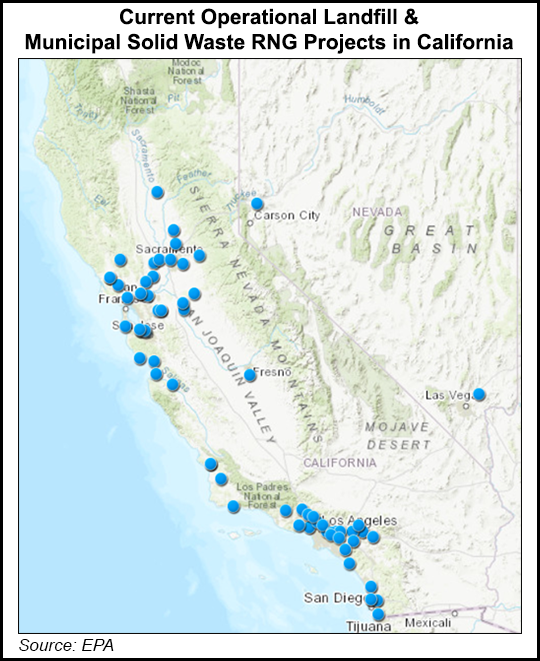Shale Daily | Infrastructure | NGI All News Access
California Eyeing RNG Building Boom
Up to 100 new or expanded production facilities for renewable natural gas (RNG) are expected to be developed in California by 2025 as the state transforms from being a major importer to developing capacity to meet growing demand.

At the third annual Power of Waste Conference in Los Angeles, executives said RNG technology is well developed and demand is growing, which can help California meet climate change challenges. The conference was jointly sponsored by Southern California Gas Co. (SoCalGas), Pacific Gas and Electric Co. and Energy Vision.
With RNG’s widespread availability through landfills, wastewater treatment plants, food processing and dairies, the California Department of Resources Recycling and Recovery estimates 50-100 new or expanded anaerobic digestion and composting facilities will be developed in the state by 2025 to meet a statewide organics diversion goal mandated in state Senate Bill 1383.
RNG is now recognized as a cost-effective means of reducing greenhouse gas (GHG) emissions, as well as other short-lived climate pollutants, aka criteria pollutants, said SoCalGas’ Yuri Freedman, senior director of business development.
A recent study by Navigant Consulting Inc. indicated that replacing about 16% of the traditional gas supply with RNG can achieve GHG emission reductions equivalent to converting 100% of the buildings to electric-only energy by 2030.
“By using a mix of both in- and out-of-state resources, RNG is about three times more cost effective in reducing GHG emissions than adopting a pure electrification strategy,” a SoCalGas spokesperson said.
Navigant surveys have been bullish about RNG for the past decade. Since 2014, the use of RNG as a transportation fuel has increased tenfold.
Of the 57 production plants in operation, 46 are supplying the transportation market while 11 serve as onsite generation fuel sources. Sixteen existing production facilities also are being expanded.
Nationally, there are thousands of potential production sites, including 8,000 dairies from which 265 have been identified longer term for development, according to the Coalition for RNG.
In California, which has three RNG production facilities, there are 200 dairies, 100 wastewater treatment plants and 50 landfills that collectively have the potential to produce between 1-2 billion diesel gallon equivalents of RNG.
© 2024 Natural Gas Intelligence. All rights reserved.
ISSN © 2577-9877 | ISSN © 2158-8023 |
